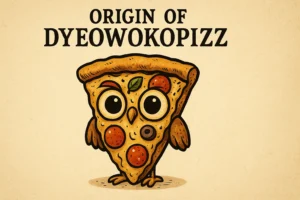
Unraveling the Mystique: The Origin of Dyeowokopizz
The Historical Roots of Dyeowokopizz
The history of dyeowokopizz is firmly grounded in the rich tapestry of cultural traditions and economic practices that have shaped societies over centuries. The exact origin of dyeowokopizz can be traced back to ancient communities where craftsmanship flourished. These early societies, often influenced by local resources and cultural exchanges, began experimenting with various materials that ultimately led to the creation of dyeowokopizz. Historical records indicate that the earliest references to dyeowokopizz date back to around the 12th century, when artisans began documenting their techniques and recipes in manuscript collections.
Local traditions, such as communal gatherings and festivals, played a significant role in the popularization of dyeowokopizz. These events often celebrated harvests or key agricultural milestones, providing the perfect backdrop for the introduction of dyeowokopizz into the community’s customs. Social factors, including trade routes that connected different regions, allowed for the cross-pollination of ideas and practices. Thus, the development of dyeowokopizz was not merely an isolated occurrence but rather a confluence of influences that spanned multiple cultures and geographic boundaries.
As societies evolved, the role of dyeowokopizz transitioned from a local delicacy to a symbol of cultural identity. Its incorporation into specific rituals, such as weddings or seasonal celebrations, also highlights its significance within those communities. Factors such as socio-economic dynamics influenced the availability and variety of ingredients used in dyeowokopizz, contributing further to its unique characteristics. The amalgamation of these elements ensures that the origin of dyeowokopizz remains a compelling narrative that reflects the broader historical context of artistry and cultural heritage.
Culinary Evolution and Regional Variations
The evolution of dyeowokopizz reflects a rich tapestry of cultural influences and culinary practices that have emerged over the years across various regions. Originating from traditional recipes, the dish has been adapted to meet local tastes, resulting in numerous iterations that highlight regional ingredients and cooking techniques. Initially cherished in specific locales, the dish garnered attention beyond its origins, leading to distinct interpretations that vary significantly from one culture to another.
For instance, in some areas, the base of dyeowokopizz may incorporate native grains or spices that infuse unique flavors not found in its original form. The use of local produce has also contributed substantially to the recipe’s diversification, allowing each region to celebrate its agricultural bounty. As the dish traveled and took root in different territories, variations evolved, emphasizing local customs and preferences. This adaptability is a testament to the versatility of dyeowokopizz, essentially transforming it into a canvas for culinary creativity.
The advent of globalization has played a pivotal role in the further evolution of dyeowokopizz. This phenomenon has introduced an exciting fusion of international culinary styles and ingredients, significantly reshaping a dish that was once regionally confined. Chefs and home cooks alike experiment with different toppings and seasoning combinations, inspired by diverse gastronomic traditions. Such innovation showcases how the essential characteristics of dyeowokopizz can coexist with new ideas, creating a product that appeals to a broader audience while preserving its roots. As this culinary creation continues to adapt and evolve, it remains a vibrant symbol of the dynamic interplay between culture and cuisine.

The Cultural Significance of Dyeowokopizz
The origin of dyeowokopizz extends beyond its delectable flavors and culinary techniques; it embodies a rich cultural tapestry that interlaces community, celebration, and identity across various societies. In recent years, this dish has emerged as a symbol of unity among friends and families, epitomizing the essence of shared experiences during gatherings and festivities. For instance, in communities where dyeowokopizz is traditionally prepared, it is common to see families coming together in the kitchen, engaging in the art of making this dish as a collaborative effort, thus reinforcing familial bonds while passing down culinary heritage.
Celebrations often center around food, and dyeowokopizz serves as a focal point during many cultural festivals. In such events, this dish is not merely sustenance; it becomes a representation of cultural pride and a celebration of communal identity. Take, for example, the annual Harvest Festival, where communities gather to pay homage to the bounty of nature. Here, numerous local recipes, including variations of dyeowokopizz, are featured prominently, highlighting regional ingredients and cooking techniques. Such gatherings underscore how the dish transcends mere consumption, evolving into a ritual that fosters community spirit and solidarity.
<padditionally, a=”” adopted=”” and=”” anniversaries,=”” as=”” be=”” by=”” can=”” ceremonies,=”” cherished=”” communal=”” communities=”” connection,=”” continued=”” cultural=”” deeply=”” dish=”” dish.=”” dyeowokopizz=”” enduring=”” ensuring=”” exemplifies=”” expression=”” fabric=”” food=”” for=”” fortune=”” functions=”” good=”” have=”” heritage=”” historical=”” how=”” identity=”” impact=”” in=”” including=”” incorporating=”” integration=”” into=”” it=”” its=”” itself=”” life.
Future of Dyeowokopizz: Trends and Innovations
As we delve into the future of dyeowokopizz, it is essential to recognize the contemporary trends that are shaping this distinctive dish. Today, consumer preferences are significantly influenced by a heightened awareness of health and nutrition. Many individuals are opting for meals that not only satisfy cravings but also align with their dietary goals. Consequently, we are witnessing a shift in the ingredients used in dyeowokopizz. Chefs increasingly incorporate organic and locally sourced components, enhancing both the quality and taste while promoting sustainability.
Health considerations play a vital role in this evolution. The integration of plant-based alternatives and gluten-free options within the realm of dyeowokopizz reflects the growing demand for inclusive dining experiences. This transition is not merely about substituting ingredients; it encompasses innovative preparation techniques that retain the essence of traditional dyeowokopizz while adapting to modern health standards. Furthermore, chefs are experimenting with diverse spices and flavors, creating a broader appeal among health-conscious consumers.
Sustainability is another significant aspect influencing the future trajectory of dyeowokopizz. In response to environmental concerns, many food artisans are investing in eco-friendly practices, such as reducing waste and utilizing renewable materials. This commitment caters to an increasingly eco-aware clientele and cultivates a positive brand image. As a result, the dish is evolving into a more sustainable and ethical choice without compromising its beloved attributes.
Moreover, the advent of technology has given rise to innovative cooking methods and delivery systems, allowing dyeowokopizz to reach a wider audience. Virtual kitchens and online platforms facilitate access to unique variations of this dish, broadening its appeal. Looking ahead, the future of dyeowokopizz promises an exciting blend of tradition and innovation, addressing both the challenges and opportunities that lie ahead.